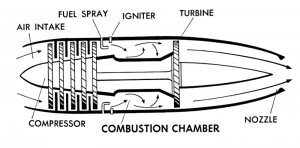Combustion chamber
A combustion chamber is the part of an engine in which fuel is burned.
Internal combustion engine
The hot gases produced by the combustion occupy a far greater volume than the original fuel, thus creating an increase in pressure within the limited volume of the chamber. This pressure can be used to do work, for example, to move a piston on a crankshaft or a turbine disc in a gas turbine. The energy can also be used to produce thrust when directed out of a nozzle as in a rocket engine.
Petrol or gasoline engine
A reciprocating engine is often designed so that the moving pistons are flush with the top of the cylinder block at top dead centre. The combustion chamber is recessed in the cylinder head and commonly contains a single intake valve and a single exhaust valve. Some engines use a dished piston and in this case the combustion chamber can be considered as partly within the cylinder. Various shapes of combustion chamber have been used, such as L-head (or flathead) for side-valve engines;"bathtub", "hemispherical" and "wedge" for overhead valve engines; and "pent-roof" for engines having 3, 4 or 5 valves per cylinder. The shape of the chamber has a marked effect on power output, efficiency and harmful emissions; the designer's objectives are to burn all of the mixture as completely as possible while avoiding excessive temperatures (which create NOx). This is best achieved with a compact rather than elongated chamber. The intake valve/port is usually placed to give the mixture a pronounced "swirl" (the term is preferred to "turbulence" which implies uncontrolled movement) above the rising piston, improving mixing and combustion. The shape of the piston top also affects the amount of "swirl." Finally, the spark plug must be situated in a position from which the flame front can reach all parts of the chamber at the desired point, usually around 15 degrees after top dead centre. It is strongly desirable to avoid narrow crevices where stagnant "end gas" can become trapped, as this tends to detonate violently after the main charge, adding little useful work and potentially damaging the engine. Also, the residual gasses displace room for fresh air/fuel mixture and will thus reduce the power potential of each firing stroke.
Diesel engine
Diesel engines fall into two broad classes:
- Direct injection, where the combustion chamber consists of a dished piston
- Indirect injection, where the combustion chamber is in the cylinder head
Direct injection engines usually give better fuel economy but indirect injection engines can use a lower grade of fuel.
Harry Ricardo was prominent in developing combustion chambers for diesel engines.
Steam engine
The term combustion chamber is also used to refer to an additional space between the firebox and boiler in a steam locomotive. This space is used to allow further combustion of the fuel, providing greater heat to the boiler.
Large steam locomotives usually have a combustion chamber in the boiler to allow the use of shorter firetubes. This is because:
- Long firetubes have a theoretical advantage in providing a large heating surface but, beyond a certain length, this is subject to diminishing returns.
- Very long firetubes are prone to sagging in the middle.
See also
